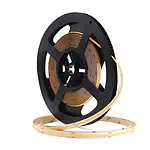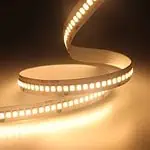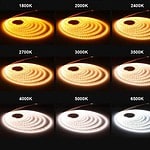Have you ever thought about how light can influence your mood? Phycology says a warm light relaxes your mind and body, creating a cozy ambiance. Likewise, our bodies respond differently to varying light intensities and colors. And to apply this color game to your lighting, you must know what dim to warm is and how it works.
Dim to warm is a lighting technology to adjust the warm tone of white lighting, creating a candle-like effect. It dims the lights controlling the flow of current. The working mechanism of dim to warm depends on the color temperature of the light. As the light dims, it decreases the color temperature creating warmer white shades.
I’ve comprehensively discussed dim to warm in this article, its working mechanism, applications, and many more. So, let’s get begin-
What is Dim to Warm?
Dim to warm is a light-dimming technology to bring different shades of a warm white. Adjusting the color temperatures of these lights, you can get a variety of warm hues.
These lightings provide a yellowish to orangish white shade. And such warm lights are great for creating an aesthetic and cozy atmosphere. That is why dim-to-warm lights are trendy for lighting bedrooms, living rooms, kitchens, workspaces, etc.
Dim to Warm: How Does It Work?
Ever noticed a dimmable incandescent bulb? Dim-to-warm technology has quite similar mechanisms to dimmable incandescent bulbs. The only difference is that the light’s intensity in such bulbs reduces, decreasing the current flow. But in LEDs with dim-to-warm, the color temperature is reduced to bring a warm white tone.
In this technology, changing the color temperature from 3000K to 1800K, various shades of white are produced. The light with the highest color temperature has the brightest hue. As you dim the light, it reduces the current flow inside the chip. As a result, the temperature of the color falls, and warm light is produced.
| Color Temperature | Brightness | Appearance |
| 3000 K | 100% | Daylight white |
| 2700 K | 50% | Warm White |
| 2400 K | 30% | Extra Warm White |
| 2000 K | 20% | Sunset |
| 1800 K | 10% | Candlelight |
So, you can see in the chart that the brightness of light decreases with the color temperature creating a warm hue. And in this way, the dim-to-warm technology works by adjusting the color temperature.
Dim to warm LED strips have two different working mechanisms based on the chip structure. These are as follows-
- Dim to Warm LED Strip Without IC Chip
The dim-to-warm LED strip without an Integrated Circuit (IC) chip combines red and blue chips to form warm hues. The blue-chip has a higher color temperature in such LED strips than the red chip. So, when you dim the light, the voltage of the blue-chip reduces faster to create a warm hue. Thus, adjusting the color temperature of red and blue chips creates a warmer glow.
- Dim to Warm LED Strip With IC Chip
Dim-to-warm LED strips with an independent chip (IC) control the current flow inside the chip. So, when you dim the LEDs, the IC chip adjusts the current flow and lowers the color temperature. As a result, it produces a cozy warm hue. And thus, dim-to-warm LED strips create a warm tone when dimmed.
Types Of Dim to Warm LEDs
There are different types of dim-to-warm LEDs. These are as follows-
Dim to Warm Recessed Lighting
Installing recessed lighting to the ceiling creates an ambient appearance. And to make this outlook more cozy, dim to warm, recessed lighting works best. It adds a natural sunlight vibe to the room with warm white shades.
Dim to Warm LED Downlight
The dim-to-warm LED downlight brings a candle-like effect to your house or office. Besides, as these lights point downward, you can use them as a spotlight to focus on any part of your room.
Dim to Warm LED Strip
Dim-to-warm LED strips are flexible circuit boards with dimmable LED chips. These chips in LED strips can change the color temperature of the light up to a fixed range to emit warm white shades. Dim-to-warm LED strips are more convenient than other dim-to-warm lighting forms. They are flexible and bendable. Plus, you can cut them to your desired length. These LED strips are suitable for accent, cabinet, cove, or commercial lighting.
The dim to warm LED strips can be of two types based on the diode or chip arrangement within the strip. These are-
- Dim To Warm SMD LED Strip: SMD refers to Surface Mounted Devices. In dim to warm SMD LED strips, numerous LED chips are populated within the printed circuit board. However, LED density is a crucial factor to consider in SMD LED strips. The higher the density, the lower hotspot it creates. So, when choosing SMD LED strips, make sure to check the LED density.
- Dim To Warm COB LED Strip: COB refers to Chip On Board. In dim to warm COB LED strips, numerous LED chips are connected directly to a flexible circuit board to form a single unit. Such dim-to-warm strips do not create hotspots. So, you can get dotless lighting with dim to warm COB LED strips.
Dim to Warm LED Bulbs
The dim to warm LED bulbs are available in various sizes. They are long-lasting and budget-friendly. Besides, you can use them creatively to create aesthetic outlooks for your interior design.
Therefore, these are the different types of dim to warm LED light. You can choose the one that suits you best.
Things To Know About Dim To Warm LED Strip
To get a better idea about dim to warm LED strips, you should have some basic idea about them. Here I’ve listed some essential facts for your convenience-
Color Temperature
The color temperature (CCT rating) is the most crucial factor when installing a dim to warm LED strip. CCT means Correlated Color Temperature and is measured in Kelvin. In the case of dim to warm, the temperature of color ranges from 3000K to 1800K. The lower the color temperature, the warmer the tone. But which temperature is ideal for your lighting project? No worries about it because you can control these temperatures according to your preferences. Yet, I’ve suggested some excellent CCT ranges for regular lighting purposes-
Recommendation For Dim to Warm
| Area | CCT Range |
| Bedroom | 2700K |
| Bathroom | 3000K |
| Kitchen | 3000K |
| Dining Room | 2700K |
| Working Space | 2700K/3000K |
For the bedroom and dining area, a warmer tone (orangish) will give a cozy vibe. Considering that, 2700 K is ideal for lighting these spaces. Again, a yellowish-warm tone at 3000K works well for more functional areas like the kitchen or bathroom. However, in dimming your working space, you can go for 2700K or 3000K, anyone that seems comfortable to your eye.
Dimming Power Supply
The dimming power supply should be compatible with the dim-to-warm LED strip. For instance- a dim to warm LED strip with a red and blue chip combination requires a voltage-regulated dimmer. But, the one that includes IC chips is compatible with PWM output dimming.
In choosing between these two categories, going for a dim-to-warm LED strip with an IC chip is a better option. That is because these strips’ PWM dimming power supply is readily available. So, no worries about finding them.
Length Of Strip
You should know the strip length when buying dim to warm LED strips. Usually, the standard size of a dim-to-warm LED strip roll is 5m. But LEDYi offers customizable options for length adjustment on all LED strips. So, contact us for customized dim to warm LED strips.
LED Density
The density of dim-to-warm LED strips determines the outlook of the lighting. So, a high-density LED strip gives better output as it eliminates hotspots. You can get 224 LEDs/m or 120LEDs/m going for LEDYi dim-to-warm LED strips.
CRI Rating
The Color Rendering Index (CRI) rates the accuracy of colors. So, the higher the CRI rating, the better the visibility. Yet, always go for CRI>90 for the best color accuracy.
Flexible Sizing
Dim to warm LED strips should have a minimal cutting length for flexible sizing. That’s why LEDYi gives a minimum cutting length of 62.5mm. So, with our LED strips, no worries about sizing.
Dimension Of LED Chip
The lighting of dim to warm varies with the dimension of LED chips. Therefore, the illumination of LED strips with more extensive sizes seems more prominent. For instance, an SMD2835 (2.8mm 3.5mm) dim-to-warm LED creates a thicker glow than SMD2216 (2.2mm 1.6mm). So, choose the dimension of the strip as per your lighting preferences.
Easy Installation
For easy installation, dim-to-light LED strips come with premium 3M adhesive tape. With these, you can easily mount them on any surface without worrying about falling.
IP Rating
Ingress Protection (IP) rating determines the level of protection of LED strips from adverse weather conditions. In addition, this rating determines whether the light is dust, heat, or waterproof or not. For example- an LED strip with IP65 indicates its resistance to dust and water. But they can’t be submerged. On the other hand, a dim to warm LED strip with IP68 can submerge in water.
For more information, you can read A Guide to Waterproof LED Strip Lights.
Voltage Drop
The voltage drop increases with the increment of length, which affects LEDs efficiency. That is why a thicker PCB (Printed Cable Board) helps to minimize the voltage drop. LEDYi keeps the PCB thickness to 2oz to optimize this voltage drop. Thus, our dim to warm LED strips do not get overheated, preventing excess voltage drop.
So, before installing a dim to warm LED strip, you should learn enough about these facts to get the best deal.
Benefits Of Dim To Warm
The dim to warm lights play a crucial role in creating a comfortable atmosphere. It creates a pleasant ambiance that gives you relaxation.
The candle-like glow of dim to warm light helps you to sleep peacefully. It brings out natural lighting that creates a calming environment around you. In addition, our body secretes the melatonin hormone that controls our sleep cycle in warm lighting. So, for healthy sleep, dim to warm lighting can be of great help.
Besides these health benefits, dim to warm also uplifts your interior designs. The warm lighting can bring an aesthetic look to your decoration.
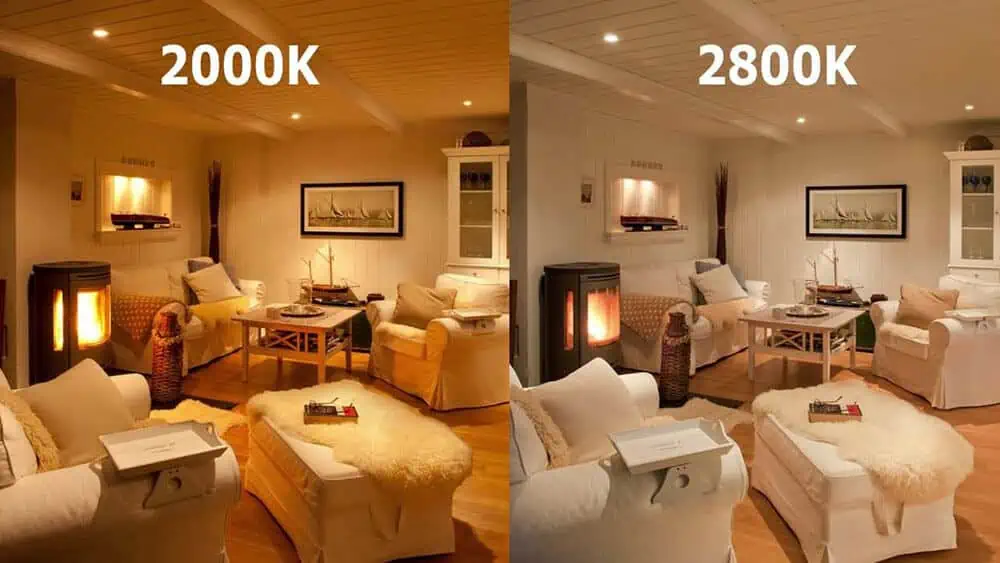
Applications Of Dim to Warm LED Strip
Dim to warm technology is suitable for various purposes. Here I’ve highlighted some common ways to apply this lighting technology-
Accent Lighting
Dim-to-warm LED strips elevate the texture of any object in your room. That is why you can use them as accent lighting. For example, placing them under the staircase or below or above walls will give an ambient look.
Cabinet Lighting
You can use dim to warm LED strips above or below cabinets to create an elegant look. Besides, installing them below the cabinet will give you better work visibility. For example, lighting under the kitchen cabinet provides you with enough lighting to work at the workstation beneath it.
Shelf Lighting
In lighting the shelf of your house or office, you can use dim to warm LED strips. It could be a bookshelf, cloth shelf, or shoe rack; dim to warm lighting works best in uplifting their appearance.
Cove Lighting
Cove lighting is excellent for creating indirect lights at home or office. You can use dim to warm LED strips on your ceiling to create cove lighting. It will give a nice cozy appearance to your bedroom or living area.
Lobby Lighting
You can use dim to warm LED strips in the hotel or office lobby. The warm tone of such lighting brings a sophisticated look to your interior design.
Toe kick lighting
The Toe kick lighting illuminates the floor of the bathroom or kitchen. Going for a dim to warm LED strip in floor lighting is a wise decision. Plus, you can experiment with the lighting outlooks to change the color temperature.
Background Lighting
In lighting the background of your monitor or any artwork, dim to warm LED strips can help. You can also install them on the back of your mirror. It will take your vanity outlook to the next level.
Commercial Lighting
Dim to warm LED strips are best for commercial lighting. You can use them in restaurants, hotels, showrooms or outlets, etc. They create a better atmosphere with cozy lighting and thus attract customers.
Besides all these applications, you can also go creative in using them.
Types Of Dimmers
Dimmer is a crucial part of dim to warm LEDs. It controls the current flow of the light. And so, to control the intensity or color temperature of lights, a dimmer is essential. Here I’ve listed some of the standard types of dimmers for your convenience-
Rotary Dimmer
Rotary dimmers are the most traditional category of light dimmers. It has a dial system. And when you rotate the dial, the intensity of the light decreases, creating a dim effect.
CL Dimmer
The letter ‘C’ of the term CL is derived from CFL bulbs, and ‘L’ is from LEDs. That is, CL dimmers are compatible with these two types of bulbs. This dimmer has a lever or switch-like structure to control the lighting.
ELV Dimmer
Electric Lower Voltage (ELV) dimmer is compatible with low-voltage halogen light. It dims the lamp by controlling the power supply of the light.
MLV Dimmer
Magnetic Low Voltage (MLV) dimmers are used in low-voltage fixtures. They have a magnetic driver to dim the bulb.
0-10 Volt Dimmer
In a 0-10 volt dimmer, the current flow in the light decreases when you switch from 10 to 0 volts. So, at 10 volts, the light will have the maximum intensity. And will dim at 0.
Integrated Dimmers
Integrated dimmers are the most modern category of light dimmers. They are very convenient to use. And you can efficiently operate them using a remote or smartphone.
So, these are the most common types of dimmers. However, before selecting any one from these, you must ensure they are compatible with your light.
For more information, you can read How to Dim LED Strip Lights.
Dim To Warm Vs. Tunable White – Are They Same?
Dim to white and tunable white may often confuse you. Many of us consider them the same, as they both deal with shades of white. But these two lights are not the same. The differences between these two lightings are as follows-
| Dim To Warm | Tunable White |
| Dim to warm LED strips bring out only the warm shades of white. | Tunable white LED strips can emit warm to cool shades of white. |
| The color temperature for dim to warm LED strips ranges from 3000 K to 1800 K. | The range in tunable white LED trips is from 2700 K to 6500 K. |
| It has a pre-set color temperature. | You can choose any temperature that falls into the range. |
| The highest temperature is the brightest shade for dim to warm. | The brightness of the light doesn’t depend on color temperature. That is, you can control the brightness of each shade. |
| Dim to warm are connected to dimmer. | It requires a connection to a tunable white LED controller for color changing. |
So, Seeing all these differences, now you know that dim to warm and tunable white are not the same. One provides only warm tones, whereas the other brings all shades of white from warm to cool. Yet, tunable white gives you more color-changing options than dim to white. And that is why they are also quite expensive compared to dim to warm.
For more information, you can read Dim to Warm VS Tunable White.
How Does A Dim to Warm Light Appear When Not Dimmed?
Dim to warm lights look the same as other LED bulbs when not dimmed. It creates a warm yellowish hue when you dim it, which is the only difference. But the regular LED bulls produce bluish or pure white shade. Aside from these, there isn’t any difference in the outlook of ordinary and dim to warm lighting.
FAQs
A dim tone means a variable warm white tone. It allows you to reduce the color temperature from 3000K to 1800K to create a warmer tone.
Dimmers need dimmable bulbs. If you connect a dimmer to a non-dimmable bulb, it can consume 5X more current. Besides, it will not dim properly and will damage the bulb. So, make sure the dimmer is compatible with the bulb.
Dim lights are used to decrease the color temperature of the light to create a warm tone. It creates a cozy atmosphere that assists you in relaxation.
Yes, dimming light means changing the color temperature. When you dim lights, the current flow inside the chip reduces, decreasing the color temperature. And thus, warmer hues are produced due to light dimming.
Dim lights create a candle-like effect. So, you can dim lights when you need soft, warm lighting for relaxation.
Blue has a color temperature above 4500 K, creating a ‘cool’ feel. In contrast, the yellow hue gives a warm and cozy vibe with a temperature ranging from 2000 K to 3000. So, although yellow has a lower color temperature than blue, it still feels warmer.
Usually, LED lights stay cool. But it is normal to get a little warm as they produce heat while operating. But too much warming indicates overheating of the LED light. And such a phenomenon damages the lights quickly.
Conclusion
Dim to Warm is a superior technology to control warm light shades. It allows you to create a relaxing environment with its dimmable color temperature options. So, you can lift your interior decoration up by installing dim to warm lighting.
Whether looking for standard dim to warm LED strips or customized ones, LEDYi can help you. We offer certified PWM and COB dim to warm LED strips, maintaining the utmost quality. Besides, with our customization facility, you can get dim to warm LED strips of your desired length, CRI, color, and more. So, contact us ASAP!




